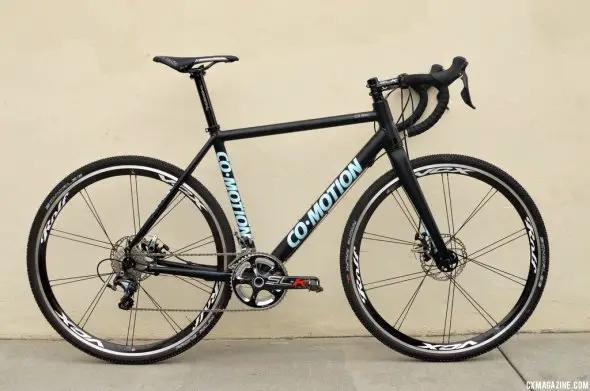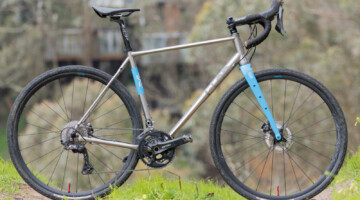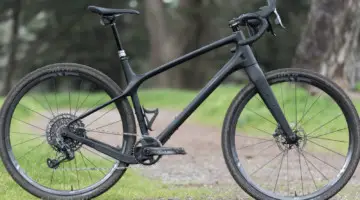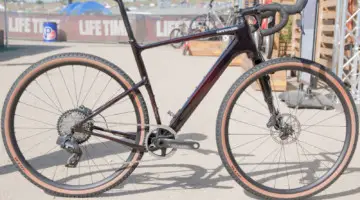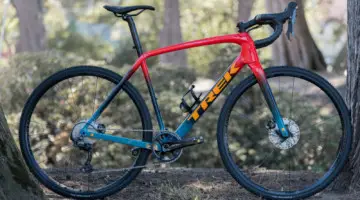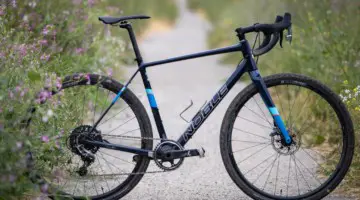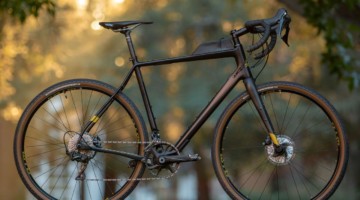The Co-Motion was originally reviewed in Issue 23 of Cyclocross Magazine along with bikes from Soma, Specialized, Raleigh, Foundry, Norco and Ritchey. You can get a back copy of Issue 23 here, but if you can’t wait, there are plenty of digital options. Download our app from iTunes (here for the iPad version and here for the iPhone version) and subscribe for access to all the cyclocross content you can handle, or browse the Apple Newsstand to see what the latest issue holds.
Co-Motion is well-known for its tandems, though when they started in Eugene, Oregon, in 1988, that was not their only production model. All along, Co-Motion has been building bikes almost exclusively with steel and aluminum for cyclists of all disciplines, barring mountain biking. For the past 25 years, though tandems are a big part of Co-Motion’s business, single bikes also play a big role. Cyclocross is a growing sport, Oregon is arguably the hotbed of cyclocross on the West Coast and Co-Motion is right there in the mix with five cyclocross models, though the company makes each bike to order, so customization is part of the experience of owning and riding a Co-Motion.
We looked at the CX Rex, a light aluminum disc brake-equipped ’cross bike, which would be the choice for a podium chance when racing in varied conditions. The cantilever version is also available—the Lucifer—but with disc brakes as the hot ticket item this season, the CX Rex was the bike to test.
Why aluminum? Co-Motion has worked with aluminum alloys for the past 25 years and can utilize its wealth of experience in building with new aluminum alloys in customized tube parameters to yield the best ride qualities for a bike’s designed application. Brian Cannon of Co-Motion explains, “Aluminum tubing has come a long way since the beginning, with advances like custom butting profiles and proprietary heat-treating cycles, for example. It’s a great material to work with and very applicable to race bikes. The aluminum frames we are building today are much lighter and more comfortable than produced in the past, comparable to high-end carbon frames.”
It’s not just them: Two other high profile companies, Trek and Van Dessel, have turned to aluminum for high-end cyclocross race bikes, fueling the aluminum renaissance. In the end, the manner of how the material is used is at least as important as what the material is.
The Frame
The frame is made using a 7005 series aluminum alloy they call ACMUltra7, a custom 7005 series aluminum alloy, with tubes drawn and butted to Co-Motion’s specifications. After welding, the frame is heat-treated by Co-Motion for strength and durability. The tubes are dimensionally “oversized” by standards even of aluminum frames of a decade ago. The down tube alone is 51.2mm in diameter, about the size of a small energy drink can.
Though the tubes are all of unusually large diameter, they are all round, and the only externally shaped tube is the tapered head tube. The frame is designed in a semi-compact style with a 6-degree sloping head tube, a 52cm seat tube (measured center-to-top) paired with a 56cm effective top tube. With a stretched out front center and chainstays just a fraction over 43cm, the CX Rex has a wheelbase that is a on the longer side at 103cm, and toe overlap is consequently minimal. The long, curved dropouts, which include the rear IS disc caliper mount, contribute to the chainstay length and add an iconic look to the rear triangle. The brake mount is set up for a 140mm rotor.
The other unconventional parameter, at least by recent American fashion, is the 6cm specified bottom bracket drop. That’s a typical position for cyclocross bikes fashioned after the European bikes up until a few years ago, when bike designers, mostly here in the U.S., began lowering the drop as the cyclocross courses include fewer technical elements. Cannon of Co-Motion mentioned that although the bike is specified with 6cm drop, since each bike is made to order, custom geometry is available, including a lower bottom bracket if desired. A PF30 bottom bracket is standard (68mm shell width, 46mm inside diameter with press in cups for the bearing cartridges and typically utilizing a 30mm aluminum alloy crank spindle).
The cables are all run externally along the down tube, with the rear brake line running alongside the shifter cables. If you use cable-actuated brakes, as on our sample, it is a full cable housing run from the bar to the caliper, so compressionless housing is desirable, though our review bike came with standard housing. The tapered head tube is 145mm long, allowing a good position for the handlebar without requiring a plethora of spacers. The CX Rex comes paired with the venerable Enve CX disc fork that has been nicely painted on the inner side of the fork legs in a color matching the graphics.
The bridged chainstays are ovalized, bent, and indented around the tire and combined with the additional length, offer good tire clearance. Frame angles are a typical 72-degrees for the head tube and 74-degrees for the seat tube.
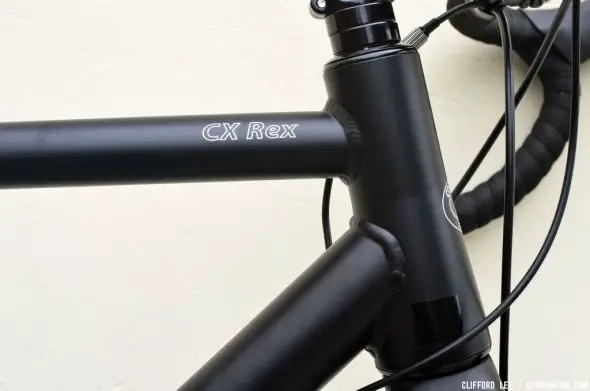
An externally tapered head tube is mated to a massive down tube with clean chunky welds on the CX Rex. © Clifford Lee
The Build
Our CX Rex model came with what Co-Motion labels the Elite Kit, which includes the new Ultegra 6800 11-speed mechanical shifting, paired with an FSA SL-K 5carbon crankset with 46/36 chainrings. Shimano does not make a specific PF/BB30 crank, instead opting for adaptors, but I like the look, potential weight savings and additional ankle clearance from the PF/BB30-specific cranks. An 11-28 Ultegra 6800 cassette with all steel cogs gave an appropriate ’cross gear spread.
TRP Spyre dual-piston mechanical disc brakes in the standard version with the aluminum actuating arm are part of the Co-Motion Elite package, and 160mm TRP rotors were set up both for the front and rear, the latter using an IS adaptor for the larger rotor.
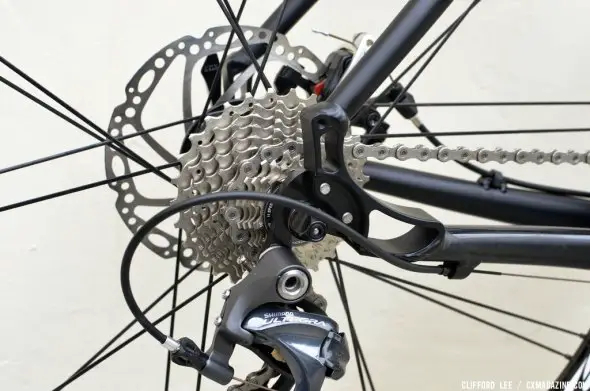
An 11-28 Ultegra 6800 cassette with all steel cogs gave an appropriate ’cross gear spread. © Clifford Lee
The wheelset included with our review bike was the Rolf Prima VCX disc, also hand-built in Eugene, Oregon, using 20 X 2 laced spokes with Rolf’s paired spoke design. The nipples are exposed, allowing for easy wheel tune-ups. The hubs include a titanium freehub body and are machined for IS 6 bolt rotors. Schwalbe Racing Ralph clinchers are standard with Co-Motion’s Elite build package.
A Selle Italia SLS saddle is perched on a Thomson alloy twin bolt seatpost, so we knew that the saddle position would be secure.
The total package yielded a 19.9 pound curb weight without pedals, 12.7 pounds without the wheels.
The Ride
One look at the bike with its “tubes of unusual size” and, biased by history, having ridden aluminum bikes with carbon forks of seemingly every variety, I jumped aboard with certain expectations. My first impression was of the high ground-to-saddle position, only a centimeter more than most bikes of recent review, but noticeable in juxtaposition. The next impression came when applying the first pedal strokes: efficient and smooth. That translated to effortless acceleration, and the bike demonstrated tame road manners as well, tracking easily when riding hands-free. Over less-than-smooth pavement, the bike felt… still smooth. That’s what 35 PSI in a 34mm tire will do, so the real test came when I took the bike off-road.
The transition from pavement to dirt, especially at race speed (faster for some than others) is always an exciting moment since the rider has to react to the bike’s handling change. A great bike has a smooth power and steering transition, requiring less effort from the rider to adjust. Too harsh and the rider has to fight for control, momentarily losing power and possibly the bike’s line; too soft and momentum is lost, taking a toll on the rider’s power. The CX Rex handled this transition like a boss. I barely had to change position or power as I plowed from pavement onto dirt, packed sand, gravel, or grass. This is not the smoothest bike over the harshest terrain, but it is definitely not the hardest ride either—actually far from it, given my preconceived notions. I felt comfortable on this bike over everything I rode, from rock and root strewn singletrack trails, underground ’cross race courses that included a gravel pit, and more traditional ’cross courses with their mix of pavement, grass, and dirt. On thick grass sections or uphill loose dirt, both power-sapping, the CX Rex performed admirably, balanced to keep the wheels on the ground and efficient enough to keep your leg power pushing the bike forward. On longer, steep, bumpy downhills, the longer wheelbase, disc brakes and bike characteristics made me feel in a semblance of control.
The TRP Spyre brakes with new pads have a light feel with good stopping power, easily on par with the best of the cable mechanical disc brakes. The dual piston design is theoretically better than the single piston design of competing models, but I have found with extensive experience over time that in use this is purely theoretical. Well adjusted versions of either will perform similarly, and ease of adjustability as the pads wear will play a role in keeping performance optimum. As with all mechanical systems, especially with full cable housing runs, compressionless cable housing will play a role in brake performance. Our review bike came with standard housing and the Spyres still felt great during our test period.
Shouldering the bike for a run up presents the need to grasp the very large diameter down tube, as I mentioned, almost the same diameter as a small energy drink can, playing with your psyche as you lift the bike to shoulder it for the run-up-in your anoxic dehydrated state, you want lift it to your lips… The cables and brake hose run along the down tube and this handful takes just a bit to adjust to. Once on your shoulder the medium radius of the top tube offers reasonable comfort, and given the almost 20 pound weight, that could be an issue for some.
Shimano’s 6800 Ultegra is one of the best mechanical systems available today, offering effortless, accurate, intuitive shifting every time, even under pedaling load. Shimano started the system based designs in 1984 when it introduced SIS (Shimano Indexed Shifting), but even paired with the FSA crankset, I did not find a bit of hesitation with front shifting. It is on par with Shimano Ultegra 6600/Dura Ace 7800, but with arguably better ergonomics!
The Verdict
The Co-Motion CX Rex with the Elite build is a great all around bike for mixed terrain adventures and racing. It handles all this with good efficiency, handling and comfort. It might sound odd to say a $5000 bike is a good value, but handmade to order in Eugene, Oregon, spec’d as is, for a bike that will take you anywhere and everywhere, it is a good value for a great bike. Get over your aluminum bias!
For more bikes, you can get a back copy of Issue 23 here, but if you can’t wait, there are plenty of digital options. Download our app from iTunes (here for the iPad version and here for the iPhone version) and subscribe for access to all the cyclocross content you can handle, or browse the Apple Newsstand to see what the latest issue holds.
For those Android-users out there, we have you covered with our app available in the Google Play store, so you’ll never have to glance longingly at your buddy’s iPad as he reads an interview with Jonathan Page or Lars van der Haar to get psyched up for a race.
And for those of you who want to read the magazine on your computer, your Kindle, or most other places, there’s Uberflip. Not only is it a cross-platform way to subscribe, Uberflip boasts (in addition to a standard subscription) our All Access Digital Pass, which allows you to read every single back issue of Cyclocross Magazine, so you can see how far we—and the sport—have come over the past few years.
Vital Stats:
- MSRP: $5500.95, $1995.99 frame only
- Frame: Co-Motion ACMUltra7 proprietary 7000 series aluminum, heat treated
- Fork: Enve CX disc, carbon. Carbon tapered steerer 1.125”-1.250”
- Weight: 19.9 lbs as equipped, 12.7 lbs without wheels
- Shifters: Shimano Ultegra 6800 11-speed
- Derailleurs: Shimano Ultegra 6800 11-speed
- Crankset: Shimano Ultegra 6800 11-speed
- Cassette: Shimano Ultegra 6800 11-speed, 11-28
- Brakes: FSA PF 30
- Wheels: Rolf VCS disc clincher, 20 paired spokes X2, external nipples F&R
- Tires: Schwalbe Racing Ralph 33
- Cockpit: FSA Gossamer alloy/FSA SL-K alloy with carbon faceplate
- Saddle: Selle Italia SLS
- Seatpost: Thomson Elite seatpost 31.6mm
- Country of origin: U.S.A.
- More Info: Co-motion.com
Clifford Lee
Latest posts by Clifford Lee (see all)
- Ridden and Reviewed: Kona Ouroboros Supreme Gravel/Adventure Bike - January 31, 2025
- The First Legendary Drop Bar Mountain Bike Racer: Jacquie Phelan - December 21, 2024
- Reviewed: Felt Breed Advanced GRX 820 Gravel Bike - September 30, 2024













